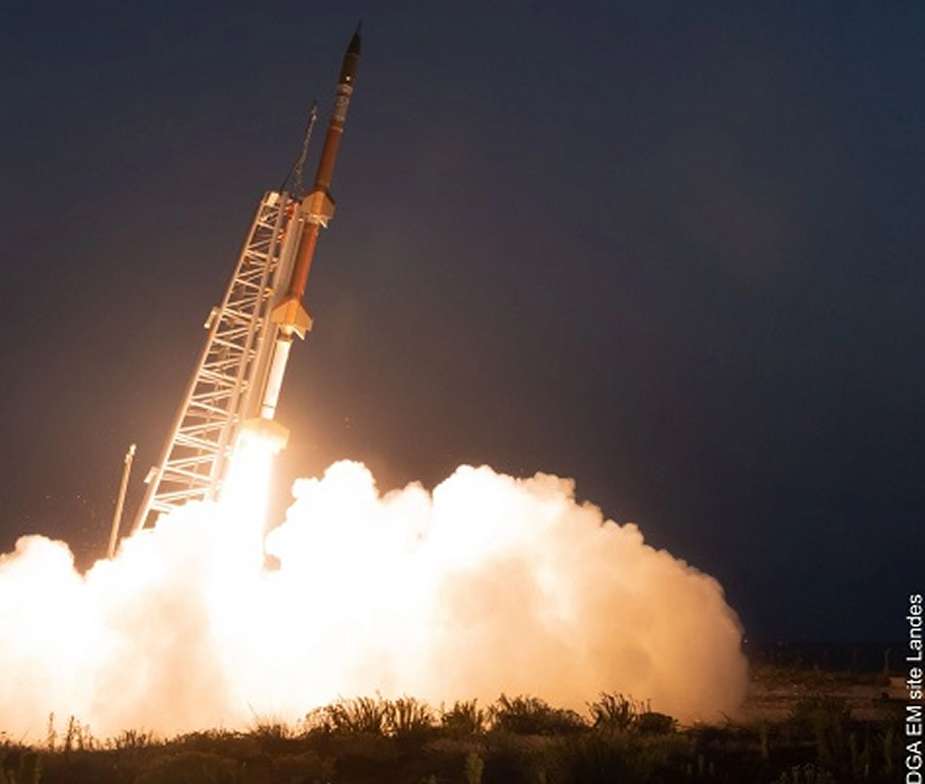Breaking news
French hypersonic glider VMaX's inaugural flight enabled by close collaboration with US Navy.
In the 1960s, Laurent Lagneau recalls in Opex360, France embarked on an ambitious project called VERAS (Experimental Vehicle for Aerothermodynamics and Structural Research) to develop an experimental glider capable of reaching hypersonic speeds, exceeding Mach 5. This endeavor aimed to achieve this feat by launching the glider with a Diamant A rocket from the Landes Testing Center in Biscarrosse. However, despite its technical aspirations, budgetary constraints eventually led to the project's abandonment in 1971.
Follow Air Recognition on Google News at this link
 On June 26, 2023, the VMaX completed its inaugural flight (Picture source: DGA)
On June 26, 2023, the VMaX completed its inaugural flight (Picture source: DGA)
Fast forward to more recent times, and the global race for hypersonic weapons has been reignited by major players like the United States, Russia, and China. France decided to rejoin this race, and the Ministry of Defense entrusted the task of developing a hypersonic glider to ArianeGroup. This effort was part of the VMaX program (Maneuvering Experimental Vehicle), first mentioned by Florence Parly, the Minister of Defense, in January 2019.
Initially, the first flight of the VMaX was scheduled for 2021, but logistical challenges delayed its launch. The main obstacle was the lack of a suitable sounding rocket and the necessary infrastructure at the Landes Testing Center, which is under the Directorate General of Armaments (DGA).
Finally, on June 26, 2023, the VMaX completed its inaugural flight. This achievement marked France's entry into the exclusive group of nations capable of launching a hypersonic glider. However, the Ministry of Defense provided limited information about the event, with a brief statement emphasizing the advanced technology embedded in the demonstrator and the technical challenges posed by its long-range flight trajectory.
Notably, the Ministry did not disclose details about the sounding rocket used for the VMaX test, although it was suggested that the United States had provided it. The reason for this secrecy was not clarified, and the matter remained shrouded in confidentiality.
Despite the limited information available, the VMaX project is a significant milestone for France, positioning the country as a player in the development of hypersonic technology.
In contrast, the U.S. Department of Defense provided more insight into the collaboration between the United States and France in this endeavor. The Pentagon revealed that the Naval Surface Warfare Center, Port Hueneme Division (NSWC PHD), played a crucial role in supporting the project. A team from NSWC PHD, typically based at the White Sands Missile Range in New Mexico, was sent to Biscarrosse to oversee the construction of launch infrastructure, develop the sounding rocket required for the VMaX launch, and provide training to DGA personnel. Additionally, three American companies—Corvid Technologies, Kratos Defense and Rocket Support Services, and Peraton—were involved in the project.
The collaboration between France and the United States extended to the construction of facilities at the Landes Testing Center. These facilities were inaugurated in October 2021 with the launch of a two-stage sounding rocket named Pathfinder, employing a Terrier-Oriole configuration. Pathfinder transmitted telemetry data before eventually crashing into the ocean.
However, for the VMaX project, a three-stage sounding rocket, utilizing a Terrier-Oriole-Oriole configuration, was necessary. This rocket was launched from Biscarrosse as part of mission FS-0 in June 2022. Unfortunately, this test failed due to an electrical short circuit during the separation of the second and third stages, causing most subsystems to malfunction.
The setback in the FS-0 mission prompted improvements in the sounding rocket. Simultaneously, integration tests of the payload, housed in a new fairing provided by Peraton, were conducted at White Sands to prepare for the FS-1 flight. FS-1 ultimately took place on June 26, 2023, two days ahead of schedule, and the rocket's engines propelled the payload to a higher altitude than planned but still within French requirements.
This successful collaboration between France and the United States is set to continue, with plans for educational initiatives, including courses on sounding rockets and practical training at both Biscarrosse and White Sands. These courses will cover technical topics such as flight performance, modeling, and structural analysis.
In summary, France's VMaX project represents a significant step in the global pursuit of hypersonic technology. While details remain limited due to security concerns, the collaboration with the United States has been pivotal in achieving this milestone, and it has the potential to benefit both nations in their respective hypersonic research endeavors.


























